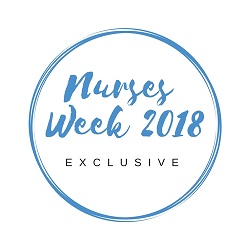Nurses As Innovators: Nurses Week 2018

By Jennifer Larson, contributor
The theme of the 2018 National Nurses Week is "Nurses: Inspire, Innovate, Influence."
As a nurse, you can do all three of those things. And perhaps you should!
“Nurses should be at the center of innovation in healthcare,” said Jone Tiffany, DNP, MA, RN a professor of nursing at Bethel University and recently the National League for Nursing’s Technology Scholar in Residence for the 2016-2017 year. “If we don’t know what needs innovating, then nobody does.”
Indeed, nurses who answer the call to be innovators can achieve significant things.
“It matters to your patients,” said Justin DiLibero, DNP, RN, CCRN, CCNS, a member of the board of directors of the American Association of Critical-Care Nurses (AACN) and clinical nurse specialist at Beth Israel Deaconess Medical Center. “It matters to your colleagues. It matters to the family members. It matters to our healthcare system.”
Nurses Who Are Inspiring and Influencing
One of the keys to innovation is problem-solving acumen. That is, when you identify a problem, your reaction starts not with a complaint but with a question: “how can I find a solution to this problem?”
“The nurse who has an inquiring mind is the one who’s an innovator,” said Margaret L. Campbell, PhD, RN, FPCN, a professor of research at Wayne State University’s College of Nursing, who was recently named the AACN’s 2018 Distinguished Research Lecturer.
Campbell is well known for her research in the area of respiratory distress, notably in assessment and treatment. In fact, she developed a tool called the Respiratory Distress Observation Scale (RDOS) that has been adapted for use in at least five languages.
But it started with her keen eye, noticing that nurses didn’t all see the same thing when they looked at a patient experiencing respiratory distress. Just because Campbell had years of experience and could easily identify even the subtlest signs of respiratory distress did not mean that every other nurse on the unit had the same experience and skill set.
“We weren’t all looking at the same patient with the same lens,” said Campbell.
She set out to develop a reliable, valid instrument that nurses could use to assess patients for respiratory distress, so that, regardless of relevant experience, everyone using the tool would be able to come to the same conclusion. The resulting tool has a series of eight variables, which are scored on a scale. For example, a nurse would give a score of 0 to a patient who is not using any extra muscles to breathe--but a score of 1 would be given to a patient who is slightly using extra muscles and a 2 to a patient who is doing so in a pronounced way.
It only takes a couple of minutes to assign a score to all eight variables. Then the nurse can look at the final score and determine the severity of the patient’s situation--and take action.
“Clinical care evolves, and we can’t just rely on ‘we’ve always done it this way,’” said Campbell.
That goes for nursing education, too, according to Tiffany.
Tiffany wanted to find ways to get nursing students more deeply engaged in the learning process, so they’ll be better prepared for the increasingly complex healthcare climate in which they’ll be practicing. She hoped to move beyond standard classroom teaching strategies like PowerPoint presentations and lectures and was inspired by the idea of using a gaming platform for an interactive learning project.
With the goal of helping faculty members encourage more active learning, she worked on developing content for Lippincott Clinical Experiences: Community, Public, and Population Health Nursing, which includes a series of virtual interactive modules for students.
When she started using this kind of technology with her students, she was pleased to see a few “Aha!” expressions. “I could see the wheels turning when we did these interactive learning strategies,” she said.
Innovation and Nursing
You, too, can be an innovator. Your experience as the bedside has prepared you to know what works and what doesn’t. If you’re passionate about something, don’t be afraid to follow that inspiration.
“Staff nurses at the bedside are in a different position for being able to drive this work forward,” noted DiLibero, who collaborated with a group of nurses on a project with AACN’s CSI Academy to find a way to improve accuracy in delirium assessments and sustain that improvement over the long run.
You can start by assessing your idea and then setting some goals, taking small steps that move you forward. Once you have an idea, DiLibero suggested finding a partner, someone who is also excited about your idea or your project. It could be a fellow staff nurse, it could be a CNS on staff at your hospital, or it might be your mentor.
Tiffany also recommended sitting down and coming up with a list of possible steps to make your idea happen. It will be easier to garner support from others if you can show that you’ve put some thought and research into your idea. Persevere when you get stalled, and don’t get bogged down by other people’s negative attitudes.
“Those looking to innovate really have to stay the course,” said Tiffany. “It may take awhile to garner that support.”
